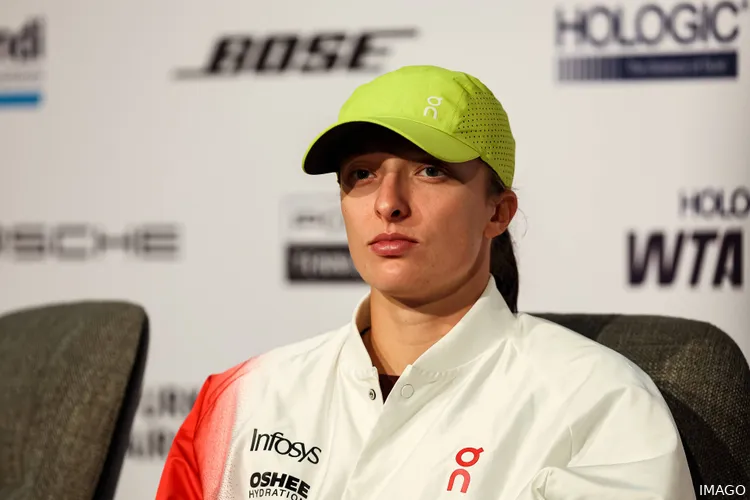
In the heart of the 2025 Stuttgart Open, Iga Swiatek, the world No. 2 and five-time Grand Slam champion, faced a familiar nemesis: Jelena Ostapenko. The quarterfinal clash on April 18 ended in disappointment for the Pole, as Ostapenko claimed a 6-3, 3-6, 6-2 victory, extending her perfect 6-0 head-to-head record. Swiatek, a clay-court maestro and two-time Stuttgart champion, was left searching for answers. When pressed in her post-match press conference about why she can’t crack the Ostapenko code, Swiatek offered a candid reflection: “I think today was a tight match, so for sure I had my chances to win.” Her response revealed both frustration and a glimmer of hope, as she grapples with a rivalry that has become her Achilles’ heel.
Swiatek’s dominance on the WTA Tour is undeniable. With 22 career titles, including four French Open crowns, she has ruled clay courts with an iron grip. Stuttgart, where she is a Porsche ambassador, has been a stronghold, with an 11-1 record before this loss. Yet, Ostapenko, the 2017 Roland Garros champion, remains her kryptonite. Their six encounters—spanning grass, hard, and now clay—have all ended in the Latvian’s favor. The latest defeat stung particularly hard, as Swiatek felt she was closer to breaking the streak. “Before, like, these matches were different,” she said, recalling earlier losses where Ostapenko’s aggressive, flat ball-striking overwhelmed her. “She was smashing every ball kind of perfectly. Today she didn’t, she made some mistakes. I had my chances. I just didn’t use them.”
Ostapenko’s game is a perfect storm for Swiatek. Her ferocious groundstrokes, which produced 29 winners to Swiatek’s 17 in Stuttgart, disrupt the Pole’s rhythm. Swiatek thrives on dictating play with her topspin-heavy forehand and impeccable defense, but Ostapenko’s pace leaves little time to set up. “I think she hates playing against me, and I love facing her,” Ostapenko quipped after the match, a cheeky nod to the mental edge she holds. Social media buzzed with speculation, with one fan noting, “Ostapenko knows she’s in Iga’s head and uses it to the max,” capturing the psychological layer of this lopsided rivalry. Ostapenko herself has long understood Swiatek’s discomfort against big hitters. “She doesn’t really like to play against big hitters,” she said after their 2023 US Open clash. “When I play fast, aggressive, and powerful, she’s a little bit in trouble.”
The Stuttgart match was a microcosm of their dynamic. Swiatek started shakily, struggling with her serve and conceding early breaks. She roared back in the second set, capitalizing on Ostapenko’s errors to level the score. “I’m happy with the second set,” Swiatek said, highlighting her improved serving and tactical adjustments. But the third set saw her falter, as Ostapenko won 12 of the first 15 points to seize control. Swiatek’s eight double faults and inability to counter Ostapenko’s relentless returns proved costly. “I lost some intensity in the third set, and that ended up being fatal,” she admitted, her disappointment palpable.
This loss adds pressure to Swiatek’s clay-court campaign, where she defends titles in Madrid, Rome, and Paris. Her 2025 season has been title-less since her 2024 Roland Garros triumph, with losses to players like Linda Noskova and now Ostapenko exposing rare vulnerabilities. Meanwhile, Ostapenko, ranked No. 24, is resurgent. Her Stuttgart run, including a win over Emma Navarro, follows a Qatar Open final in February, where she also dispatched Swiatek 6-3, 6-1. “I was pretty confident I would beat her,” Ostapenko said in Doha, a confidence born from knowing “how to hurt her.”
Swiatek’s challenge is both technical and mental. Ostapenko’s unpredictable aggression—24 winners to 15 unforced errors in Stuttgart—neutralizes Swiatek’s return game, typically a strength. “I wasn’t able to play anything before, like, any tactics,” Swiatek noted, admitting she struggled to impose her game plan. Yet, she remains optimistic, believing consistency could turn the tide. “I did that in the second set, so it was just a matter of keeping it for the whole match,” she said. As the clay season unfolds, Swiatek faces a daunting field, including Aryna Sabalenka and Elena Rybakina, both big hitters who have troubled her.
For now, Ostapenko’s dominance endures, a rare blemish on Swiatek’s glittering resume. The Pole’s quest to solve this puzzle is about more than one rivalry—it’s about proving she can conquer any challenge. As she prepares for Madrid, her words linger: “I’ll just have another chance, and I’ll try to use it.” Tennis fans await the next chapter, wondering if Swiatek can finally break the spell or if Ostapenko’s hoodoo will continue to haunt her.
Leave a Reply